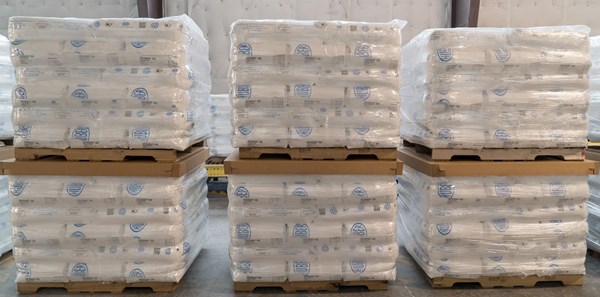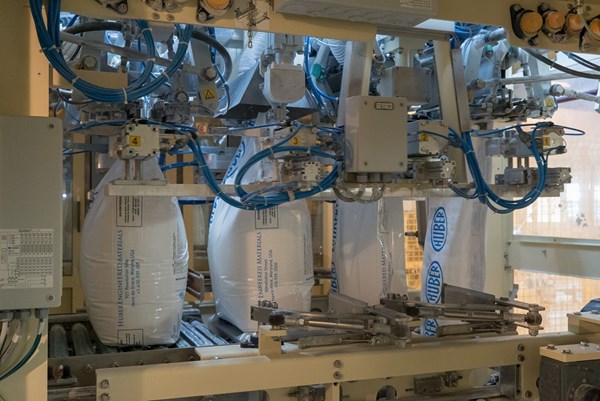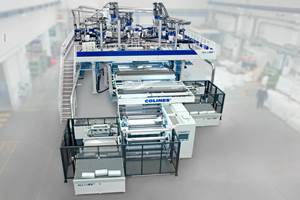LLDPE Replaces Paper In Additive Packaging
The new packaging system replaces paper bags with more robust LLDPE bags.

The new packaging system replaces paper bags with more robust LLDPE bags.
Among the many times through the years that I have reported on plastic chemicals and additives news, I’d say it’s been less than a handful of times where the topic was about their packaging. Typically, it’s about new and/or improved versions of additives that improve performance of plastics and/or their physical form (e.g., pellets, beads) which allow for easier handling. Some small particle additives, in particular, have traditionally posed particular challenges.
So, I found it interesting to hear that J.M. Huber Corp.’s Huber Engineered Materials division had invested in an innovative, multi-million dollar packaging system, which replaces paper bags with a conversion to more robust LLDPE bags at its precipitated amorphous silica Havre de Grace, Md., production facility. Huber’s silicas and silicates are used in a variety of industries and when targeted as an anti-blocking agent for plastics, polyolefins is a key application.
A Huber spokesman explained that the new filling technology and use of LLDPE bags for small particle materials such as silicon dioxide is just emerging. “Use of plastic bags is more and more common for gardening items and masonry materials….those industries have been converting for many years but are much easier to package than silica because of the large particle sizes and high bulk density. The expertise in the design of the packaging equipment, coupled with the emerging technology in the design of the films used to create the LLDPE bags effectively adapts to handling silica’s unique properties,” he says.
Asked if the LLDPE choice is unusual for packaging these type of additives, the Huber source notes that PP is most commonly used in both Asia, where sacks are reused for other purposes, and India, due to lack of trees/paper. He notes, however, that these PP bags release considerably more dust and are manually filled. Here’s more on Huber’s system and bags:
• Huber’s new packaging platform is being introduced systematically across the globe with automatic filling equipment already in place in select production facilities in the European and American regions, with the intention to do the same in Asia in 2017. (The company is a global leader in precipitated silica with seven manufacturing sites strategically located across North America, Europe, and Asia.)
• The improved LLDPE bags offer stronger tensile strength.
• The LLDPE bags minimize the nuisance of dust.
• They eliminate trapped air within each LLDPE bags, making the packages more easily stackable for more stable pallets during shipment, unloading, and warehousing.
• The LLDPE bags also provide increased printing and labeling options.
• The new packaging is also easily recyclable which is integral to Huber’s commitment to sustainability.
According to the Huber spokesman, the novel packaging’s development was also influenced by customers’ requests for improved performance over paper bags—which are susceptible to moisture, excessive dusting, improved recycling needs, emerging food safety, and employee health exposure regulations.
For more on Huber and additives offered, see PT’s additives database.

Related Content
Young Stretch-Film Processor Bets on Nanolayers
Going up against companies with as much as double its capacity, young stretch-film processor Zummit believes that new technology — notably 59-nanolayer films — will give it a competitive edge.
Read MoreWisconsin Firms Unite in Battle Against Covid
Teel Plastics opened new plant in record time, partnering with AEC & Aqua Poly Equipment Co. to expand production of swab sticks to fight pandemic.
Read MoreFoam-Core Multilayer Blow Molding: How It’s Done
Learn here how to take advantage of new lightweighting and recycle utilization opportunities in consumer packaging, thanks to a collaboration of leaders in microcellular foaming and multilayer head design.
Read More‘Monomaterial’ Trend in Packaging and Beyond Will Only Thrive
In terms of sustainability measures, monomaterial structures are already making good headway and will evolve even further.
Read MoreRead Next
Understanding Melting in Single-Screw Extruders
You can better visualize the melting process by “flipping” the observation point so that the barrel appears to be turning clockwise around a stationary screw.
Read MoreAdvanced Recycling: Beyond Pyrolysis
Consumer-product brand owners increasingly see advanced chemical recycling as a necessary complement to mechanical recycling if they are to meet ambitious goals for a circular economy in the next decade. Dozens of technology providers are developing new technologies to overcome the limitations of existing pyrolysis methods and to commercialize various alternative approaches to chemical recycling of plastics.
Read MoreHow Polymer Melts in Single-Screw Extruders
Understanding how polymer melts in a single-screw extruder could help you optimize your screw design to eliminate defect-causing solid polymer fragments.
Read More














.png;maxWidth=300;quality=90)











